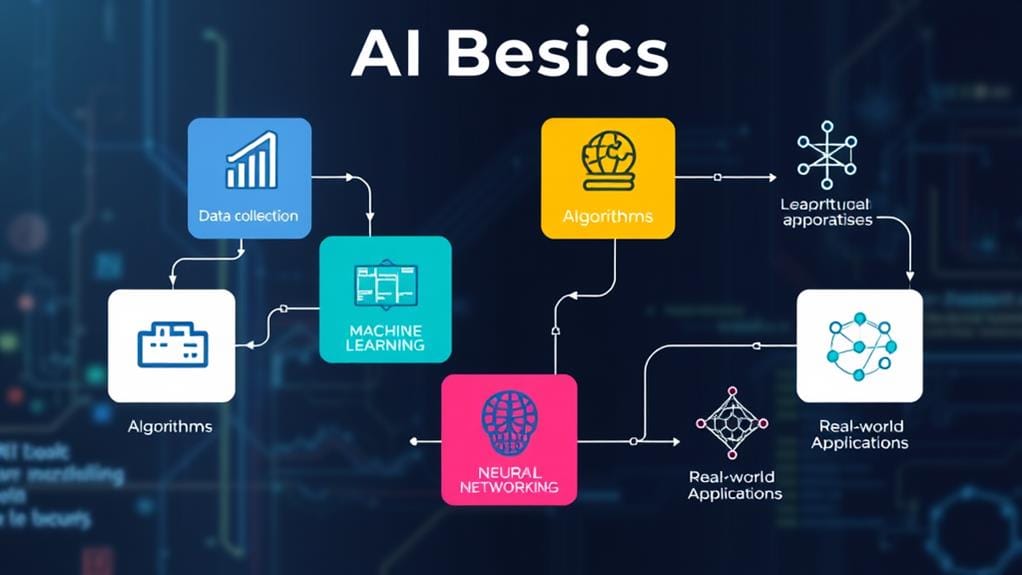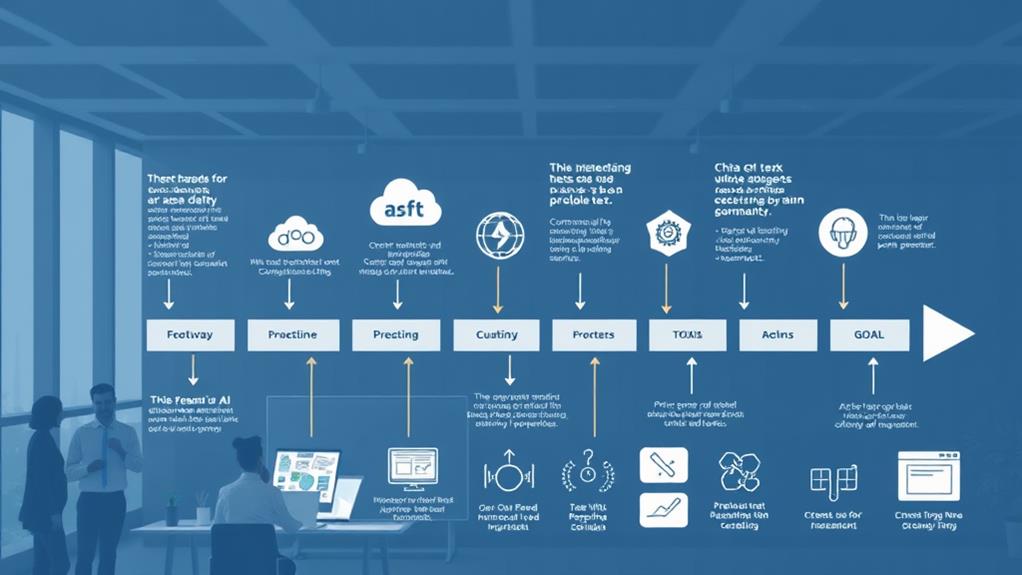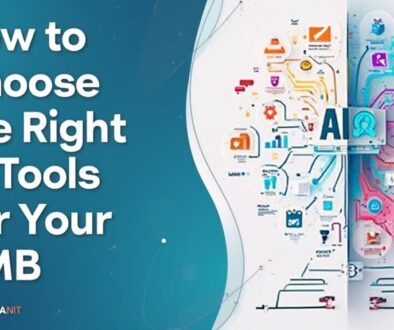AI Implementation: A Roadmap for SMBs
Implementing AI in small and medium-sized businesses (SMBs) requires a systematic approach. Start by understanding AI fundamentals and ethical implications. Identify specific business needs and set measurable objectives that align with strategic goals. Choose appropriate tools by evaluating software compatibility, costs, and vendor support. Develop a thorough implementation plan that involves training your team to foster a culture of continuous learning. Measure success with defined performance metrics and assess ROI to refine strategies. By following this roadmap, SMBs can effectively enhance efficiency and engagement. Discovering the next steps will provide further insights into scaling AI solutions for sustained growth.
Key Takeaways
- Understand AI basics and ethical considerations to ensure responsible usage and stay competitive in the market.
- Identify specific business needs and set measurable objectives to effectively implement AI solutions.
- Choose the right tools by analyzing features, costs, and compatibility with existing systems.
- Invest in training and upskilling employees to maximize productivity and encourage a culture of continuous learning.
- Measure success through defined performance metrics and conduct ROI assessments to evaluate the financial impact of AI solutions.
Understanding AI Basics

As businesses increasingly turn to technology for competitive advantage, understanding the fundamentals of artificial intelligence (AI) becomes essential for small and medium-sized businesses (SMBs). At its core, AI encompasses diverse capabilities, including machine learning, data analysis, and natural language processing. These technologies enable organizations to derive actionable insights from large datasets, improving decision-making processes.
Machine learning, a subset of AI, empowers algorithms to learn from and adapt to data, presenting opportunities for predictive analytics across various industry applications. Furthermore, neural networks—complex algorithms inspired by human brain function—facilitate advancements in computer vision and natural language understanding, transforming how SMBs interact with customers. For instance, such technologies allow for enhanced user experience through tailored recommendations and automated customer service systems.
However, the adoption of AI does not come without ethical considerations. Algorithm bias presents significant challenges, as AI systems can inadvertently perpetuate existing biases present within training data. Understanding these implications is essential for responsible AI deployment.
Keeping abreast of AI trends is critical for SMBs to stay competitive. The focus should not only be on adopting innovative solutions but also on ensuring that ethical standards govern their use.
This strategic approach to AI fundamentals, alongside awareness of its implications, will enable SMBs to leverage technology effectively while fostering a culture of responsibility and equity in their operations. The proper integration of AI can ultimately enhance efficiency, drive growth, and improve customer satisfaction.
Identifying Business Needs
To effectively implement AI solutions, SMBs must first identify their unique business needs and challenges. This initial step is essential as it lays the foundation for a successful AI strategy tailored to the organization's specific context.
Businesses should start by conducting a thorough analysis of their current processes, focusing on areas where data analysis can reveal insights about operational inefficiencies and customer behavior.
Reviewing existing workflows will highlight potential opportunities for process automation, leading to significant gains in operational efficiency. For example, automating routine tasks can free up valuable resources, allowing teams to focus on more strategic initiatives.
Additionally, enhancing customer engagement through personalized experiences powered by AI can drive retention and foster loyalty.
SMBs must also consider risk management. Understanding market trends and potential disruptions in the industry will empower businesses to develop proactive strategies that mitigate risks, providing a competitive advantage in an ever-changing landscape.
Lastly, a critical aspect of identifying business needs involves evaluating resource allocation. Effectively utilizing AI solutions demands a clear understanding of both human and technological resources available.
Setting Clear Objectives

Frequently, organizations that implement AI solutions without clear objectives risk misalignment between technology and business outcomes. This disconnect can lead to wasted resources, diminished morale, and ultimately, a lack of competitive advantage. Establishing unequivocal goals is essential for Small and Medium-sized Businesses (SMBs) enthusiastic to harness the transformative power of AI effectively.
To begin, it is important to formulate specific, measurable objectives that resonate with the overall strategic aim of the organization. These objectives should not only reflect the desired outcomes but also serve as guiding beacons for all AI-related activities. In this situation, goal alignment plays a significant role in ensuring that every team member understands the purpose behind implementing AI, thereby fostering a culture of collaboration and enthusiasm towards shared aspirations.
Moreover, identifying relevant performance metrics is important for tracking progress and measuring success. By establishing key performance indicators (KPIs) associated with the set objectives, organizations can gain insight into the effectiveness of their AI initiatives. Such metrics allow for real-time adjustments, ensuring that projects remain aligned with the intended goals.
Choosing the Right Tools
Achieving clarity in objectives sets the stage for the next essential step: selecting the appropriate tools to implement AI successfully. A rigorous tool evaluation process is necessary, beginning with a thorough feature comparison to guarantee the chosen software aligns with your defined objectives.
Evaluating software compatibility with existing systems is critical to mitigate integration challenges that could impede AI deployment.
In the vendor selection phase, consider multiple options. Conduct a cost analysis to understand long-term investments versus short-term expenditures, assuring that financial resources support scalability options to future-proof your AI solutions.
User feedback from current clients can provide invaluable insights into a vendor's reliability and performance, reducing the risks associated with new software adoption.
It is important to evaluate support services offered by potential vendors, as ongoing assistance will be essential in tackling any unforeseen issues post-implementation.
Trial periods can also serve as a testing ground, allowing you to experience the software's functionalities firsthand and gauge its impact on your operations.
Engaging in this analytical approach empowers SMBs to make informed decisions when selecting AI tools.
This freedom to choose the right solutions, based on thorough evaluations, will lay the foundation for successful AI integration and ultimately drive your business towards greater innovation and efficiency.
Developing a Implementation Plan

A thorough implementation plan is essential for the successful integration of AI solutions within SMBs. Such a plan not only outlines objectives but also addresses potential challenges. It serves as a strategic guide to enable businesses to harness AI's transformative power, guaranteeing that implementation aligns with the company's unique goals and capabilities.
Consider these three critical components when developing your implementation plan:
1. Budget Considerations: Identify the financial resources required for AI tools, including licensing costs, integration expenses, and ongoing maintenance.
Prioritize these expenses to prevent financial strain on the business.
2. Timeline Estimation: Establish a clear timeline to facilitate the process. This includes phases such as assessment, selection of tools, implementation, and monitoring.
Creating a realistic timeline helps manage expectations and promotes accountability within the team.
3. Stakeholder Engagement: Involve key stakeholders early in the process to foster buy-in and guarantee that AI solutions meet the needs of all departments.
Regular feedback from these stakeholders will also assist in identifying potential hurdles as the project progresses.
Training Your Team
Training your team is essential for successful AI implementation, as upskilling employees equips them with the necessary knowledge to effectively utilize new technologies.
Leveraging external resources, such as specialized training programs and industry workshops, can further enhance your team's competence and confidence.
Investing in extensive training not only boosts productivity but also fosters a culture of innovation within the organization.
Importance of Upskilling
While the integration of AI technologies presents significant opportunities for small and medium-sized businesses (SMBs), the success of such initiatives largely hinges on the skills and competencies of the team executing them.
Upskilling your workforce is not merely an option but a necessity in fostering an innovation culture that thrives in today's competitive landscape.
Consider the following key aspects of upskilling:
- Continuous Learning: To stay ahead, employees must engage in ongoing education related to AI and emerging technologies, enhancing both their technical and soft skills.
- Adaptability Strategies: A well-rounded training program fosters employees' ability to adapt to new tools and processes, which is vital in a rapidly evolving technological environment.
- Knowledge Sharing: Encourage a culture of collaboration where team members share insights and experiences. This collective intelligence accelerates technology adoption and employee development.
Investing in workforce training not only equips your team with essential skill enhancements but also promotes an environment where innovation can flourish.
As companies prioritize employee development, they pave the way for successful AI implementation that can ultimately propel their business forward.
Leveraging External Resources
How can SMBs effectively enhance their teams' skills in maneuvering AI technologies? A strategic approach involves leveraging external resources through various avenues. By forming external partnerships with educational institutions or tech vendors, SMBs can facilitate access to targeted training programs tailored to AI applications pertinent to their industry.
These collaborations not only promote knowledge sharing but also align with industry benchmarks, ensuring that employees acquire relevant competencies.
Effective resource allocation is vital, particularly in identifying funding opportunities that can support training initiatives. Vendor selection should prioritize partners offering thorough training modules and ongoing support, which are essential for sustaining skill development.
Additionally, engaging with community resources such as local tech hubs or industry meetups can foster continuous learning and exposure to innovative practices.
Implementing collaboration strategies, such as forming study groups or mentorship programs, can further empower teams to explore AI technologies cohesively.
Incorporating these approaches will not only create a more skilled workforce but also instill a culture of innovation, adeptly positioning SMBs to adapt and thrive in an increasingly AI-driven landscape.
Measuring Success

Evaluating the effectiveness of AI implementation for small and medium-sized businesses (SMBs) requires a strategic approach that encompasses both quantitative and qualitative metrics.
To truly understand the impact of AI initiatives, SMBs must establish a robust framework for measuring success, focusing on areas that contribute to overall business goals.
Here are three essential components for measuring AI implementation success:
- Performance Metrics: Define clear performance metrics aligned with business objectives. These can include productivity improvements, cost savings, and operational efficiency. Benchmarking against industry standards can provide a comparative viewpoint.
- User Feedback: Engage with all stakeholders to gather user feedback on AI tools and processes. Understanding their experience can highlight areas for enhancement and foster a culture of continuous improvement.
- ROI Assessment: Conduct a detailed ROI assessment to evaluate the financial impact of AI solutions. This should include direct cost savings as well as indirect benefits such as enhanced customer satisfaction and increased sales opportunities.
In adopting these approaches, SMBs can create a reliable project evaluation strategy that not only measures success benchmarks but also integrates stakeholder engagement for ongoing improvement.
By leveraging data analytics, businesses can identify trends and optimize their AI strategies, ensuring they remain agile and responsive to market changes.
Ultimately, this structured method of measuring success will lead to informed decision-making and an empowered workforce, aligning the organization with its broader ambitions.
Scaling AI Solutions
Building on the established metrics for measuring AI implementation success, the next step for small and medium-sized businesses (SMBs) involves successfully scaling these AI solutions across their operations. This phase presents unique AI adoption challenges, such as guaranteeing that new technologies can seamlessly integrate with legacy systems without causing disruptions. A robust integration strategy is essential to maintain operational continuity while expanding AI applications.
Cost management strategies must also be prioritized to control expenses during this scaling process. SMBs should assess the total cost of ownership, considering both initial investments and ongoing operational costs, to guarantee sustainable budgeting.
In addition, data privacy concerns are paramount; businesses need to establish clear protocols for data handling and user consent to prevent breaches and maintain trust.
Alignment with company culture plays a critical role in the successful scaling of AI solutions. Engaging employees in this journey and addressing their ethical AI considerations can foster a positive attitude towards new technologies. To this end, clear communication about how AI will enhance their roles can alleviate fears and encourage adoption.
When selecting vendors, careful consideration of vendor selection criteria is crucial. This includes understanding their capabilities in supporting long-term sustainability plans and verifying they share the SMB's values on ethics and data governance.
Frequently Asked Questions
What Budget Is Needed for Initial AI Implementation in Smbs?
Determining the budget for initial AI implementation in small and medium-sized businesses (SMBs) involves careful cost estimation of both initial costs and ongoing expenses.
A thorough budget allocation should include software, hardware, and personnel training. Potential funding sources include grants or partnerships.
Additionally, conducting a robust ROI analysis will assist in justifying expenditures and ensuring sustainable growth.
Ultimately, aligning financial resources with strategic goals is essential for effective implementation and long-term success.
How Do I Select AI Vendors for My Business?
Selecting the right AI vendor can feel like maneuvering through a maze with unknown twists.
To streamline your vendor evaluation process, establish clear criteria that emphasize solution scalability and alignment with your business objectives.
Assess potential partners based on their track record, technological capabilities, and support offerings.
Engaging in pilot projects can also provide insights into their adaptability and responsiveness, empowering you to make an informed choice that guarantees long-term value for your organization.
What Common Mistakes Should SMBS Avoid During AI Implementation?
During AI implementation, SMBs should avoid several common mistakes:
Neglecting data quality can lead to inaccurate outcomes, while insufficient change management hampers organization-wide acceptance.
Employee training is essential; failing to prepare staff may result in resistance or underutilization of AI tools.
Additionally, ineffective use case identification may waste resources.
Businesses must also address integration challenges early and establish clear performance metrics to measure success, ensuring a strategic approach to AI adoption.
How Long Does It Take to See AI Benefits?
The journey to reaping the rewards of artificial intelligence can seem like waiting for a pot to boil—time may stretch, but significant benefits often emerge within 3 to 6 months post-implementation.
This timeline varies, driven by the sophistication of the applications deployed. Organizations can expect measurable outcomes, such as enhanced efficiency and improved decision-making, but this requires a solid foundation and ongoing evaluation to maximize the potential of their AI investments.
Can AI Improve Customer Service in Smbs?
Yes, AI can considerably enhance customer service in small and medium-sized businesses (SMBs).
By employing personalization strategies, businesses can tailor interactions to individual customer preferences, leading to improved satisfaction and loyalty.
Additionally, chatbot technologies provide immediate support, responding to inquiries efficiently and effectively, which frees human agents to tackle more complex issues.
This combination not only streamlines operations but also fosters a customer-focused environment that encourages deeper engagement and loyalty.
Conclusion
To summarize, the implementation of AI within small and medium-sized businesses represents not merely a technological upgrade, but a transformative journey that can redefine operational landscapes and spur innovation. The roadmap delineated provides essential steps to navigate this complex domain. Embracing AI is akin to planting a seed; with careful nurturing and strategic foresight, robust growth can be achieved, ultimately leading to increased competitiveness and sustainability in an ever-evolving market.




